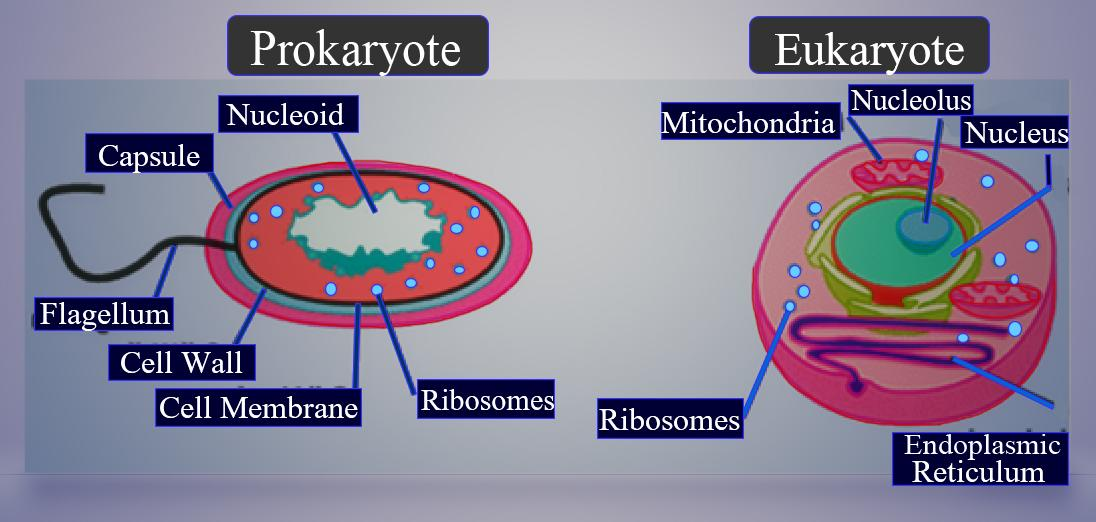
True nucleus is absent in
A. Green algae
B. Fungi
C. Lichens
D. Bacteria
Answer
572.1k+ views
Hint: They are a typical biological cell with a large group of prokaryotic organisms varying in shapes, structures, and sizes, and are found in almost all the habitats.
Complete answer:
A true nucleus is absent in the case of the prokaryotic cell of an organism and it is present in the eukaryotic cells. The prokaryotic cells mostly belong to the bacteria cells, instead of nucleus they contain a nucleoid region where the genetic material is present.
Additional Information: -Bacteria were among the first life forms to appear on the earth, and are found in almost all the habitats.
-The word bacteria is derived from the Greek word bakteria meaning “staff, cane” because the first discovered were the rod-shaped bacteria.
-The evolution of archaea and eukaryotes was the second-largest evolutionary divergence that involved bacteria also.
-The cells lack any membrane and membrane-bound cell organelles. They do not have a true genetic material instead consisting of DNA which is composed of single circular bacterial chromosomes. All the genetic material is arranged irregularly and is found in the nucleoid.
-The nucleoid consists of the chromosome with its associated proteins and RNA.
-Bacteria usually lack large membrane-bound organelles like the nucleus, mitochondria, chloroplast, etc.
-Bacteria contain ribosomes for the synthesis of the proteins.
-The outer layer of the prokaryotic cell has attached flagella which help in the movement.
So, the correct answer is ‘Bacteria’.

Note: Green algae are the eukaryotic cells while blue-green algae come under prokaryotic cells that lack a nucleus. The fungi are eukaryotic organisms having a small nucleus containing the genetic material (DNA). The lichens may be prokaryotic or eukaryotic organisms, but most commonly they belong to the eukaryotic group.
Complete answer:
A true nucleus is absent in the case of the prokaryotic cell of an organism and it is present in the eukaryotic cells. The prokaryotic cells mostly belong to the bacteria cells, instead of nucleus they contain a nucleoid region where the genetic material is present.
Additional Information: -Bacteria were among the first life forms to appear on the earth, and are found in almost all the habitats.
-The word bacteria is derived from the Greek word bakteria meaning “staff, cane” because the first discovered were the rod-shaped bacteria.
-The evolution of archaea and eukaryotes was the second-largest evolutionary divergence that involved bacteria also.
-The cells lack any membrane and membrane-bound cell organelles. They do not have a true genetic material instead consisting of DNA which is composed of single circular bacterial chromosomes. All the genetic material is arranged irregularly and is found in the nucleoid.
-The nucleoid consists of the chromosome with its associated proteins and RNA.
-Bacteria usually lack large membrane-bound organelles like the nucleus, mitochondria, chloroplast, etc.
-Bacteria contain ribosomes for the synthesis of the proteins.
-The outer layer of the prokaryotic cell has attached flagella which help in the movement.
So, the correct answer is ‘Bacteria’.

Note: Green algae are the eukaryotic cells while blue-green algae come under prokaryotic cells that lack a nucleus. The fungi are eukaryotic organisms having a small nucleus containing the genetic material (DNA). The lichens may be prokaryotic or eukaryotic organisms, but most commonly they belong to the eukaryotic group.
Recently Updated Pages
Master Class 12 Business Studies: Engaging Questions & Answers for Success

Master Class 12 Economics: Engaging Questions & Answers for Success

Master Class 12 English: Engaging Questions & Answers for Success

Master Class 12 Maths: Engaging Questions & Answers for Success

Master Class 12 Social Science: Engaging Questions & Answers for Success

Master Class 12 Chemistry: Engaging Questions & Answers for Success

Trending doubts
What is meant by exothermic and endothermic reactions class 11 chemistry CBSE

Which animal has three hearts class 11 biology CBSE

10 examples of friction in our daily life

One Metric ton is equal to kg A 10000 B 1000 C 100 class 11 physics CBSE

1 Quintal is equal to a 110 kg b 10 kg c 100kg d 1000 class 11 physics CBSE

Difference Between Prokaryotic Cells and Eukaryotic Cells




